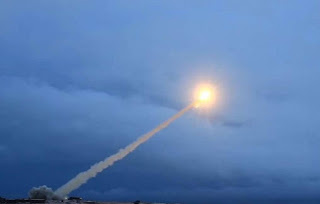The Petrel is a dirty bird- and a dangerous one
In early August a nuclear detonation off the northern coast of Russia claimed seven lives in what seems to have been a test of the hypersonic nuclear-powered cruise missile which President Putin has made the centerpiece of a new arms race with the United States.
The idea behind the weapon, called the 9M730 Burevestnik (Petrel) by the Russians and known to NATO as the SSC-X-9 Skyfall, is a missile so fast that American anti-ballistic missile technology would be unable to intercept it. The Russians have been terrified by the prospect of effective ABM technology ever since the days of Ronald Reagan, viewing it as inherently destabilizing and balking even at offer by Mr. Reagan to share any such technology developed by the United States with Russia.
The idea isn't new. In the 1950s, the United States poured a great deal of money and effort into a top-secret undertaking called Project Pluto, inspired precisely by the fear that ABM technology might eventually neutralize our nuclear deterrent. The centerpiece of Project Pluto was SLAM, a hypersonic missile powered by a nuclear ramjet and capable of flying literally for months without running out of fuel. SLAM would have flown back and forth over enemy territory for extended periods at low altitudes and speeds generating sound waves more than twice as loud as required to shatter the human eardrum, spreading lethal radiation over broad swaths of territory before ultimately delivering up to 26 thermonuclear warheads.
It was a scary, ugly weapon whose development was halted for reasons of practicality. To begin with, by its very nature SLAM would do the same damage to friendly territory it flew over as it would to enemy territory. And testing it would be almost impossible. Even doing it over remote areas of the ocean (one plan was to finally crash the incredibly radioactive weapon in the Marianas Trench) would be incredibly dangerous, and a mishap anywhere near populated areas would be catastrophic.
The nature of the Burevestnik isn't entirely clear, beyond the fact that it is powered by a nuclear reactor, but it is thought to be similar in technology to SLAM. There is no question but that if successfully developed and deployed, it would be a strategic game-changer. But the practical obstacles which led to the abandonment of Project Pluto remain. Will the Russians ignore them, and persevere, despite the minor disaster caused by the failure of the first test of the missile? Or will Putin give up his idea of an unstoppable answer to American ABM technology which would give Russia a huge strategic advantage and return some of the prestige and self-respect lost with the collapse of the Soviet superpower?
It's hard to say. One thing, though, is certain: despite the claims of some on both the right and the left that the threat of strategic nuclear aggression has vanished with the end of the cold war, that terrorists now pose the only real nuclear threat, and that defense spending aimed at maintaining a credible nuclear deterrent is no longer necessary now that the Cold War has ended, the threat has hardly vanished and that the preservation of such a deterrent will remain a matter of vital national security for the foreseeable future.
And Burevestnik is one more reason why Mr. Trump's apparent inclination to see the Russian bear as cute and cuddly rather than dangerous is itself a dangerous and potentially disastrous misreading of the facts.
Photo: TASS
The idea behind the weapon, called the 9M730 Burevestnik (Petrel) by the Russians and known to NATO as the SSC-X-9 Skyfall, is a missile so fast that American anti-ballistic missile technology would be unable to intercept it. The Russians have been terrified by the prospect of effective ABM technology ever since the days of Ronald Reagan, viewing it as inherently destabilizing and balking even at offer by Mr. Reagan to share any such technology developed by the United States with Russia.
The idea isn't new. In the 1950s, the United States poured a great deal of money and effort into a top-secret undertaking called Project Pluto, inspired precisely by the fear that ABM technology might eventually neutralize our nuclear deterrent. The centerpiece of Project Pluto was SLAM, a hypersonic missile powered by a nuclear ramjet and capable of flying literally for months without running out of fuel. SLAM would have flown back and forth over enemy territory for extended periods at low altitudes and speeds generating sound waves more than twice as loud as required to shatter the human eardrum, spreading lethal radiation over broad swaths of territory before ultimately delivering up to 26 thermonuclear warheads.
It was a scary, ugly weapon whose development was halted for reasons of practicality. To begin with, by its very nature SLAM would do the same damage to friendly territory it flew over as it would to enemy territory. And testing it would be almost impossible. Even doing it over remote areas of the ocean (one plan was to finally crash the incredibly radioactive weapon in the Marianas Trench) would be incredibly dangerous, and a mishap anywhere near populated areas would be catastrophic.
The nature of the Burevestnik isn't entirely clear, beyond the fact that it is powered by a nuclear reactor, but it is thought to be similar in technology to SLAM. There is no question but that if successfully developed and deployed, it would be a strategic game-changer. But the practical obstacles which led to the abandonment of Project Pluto remain. Will the Russians ignore them, and persevere, despite the minor disaster caused by the failure of the first test of the missile? Or will Putin give up his idea of an unstoppable answer to American ABM technology which would give Russia a huge strategic advantage and return some of the prestige and self-respect lost with the collapse of the Soviet superpower?
It's hard to say. One thing, though, is certain: despite the claims of some on both the right and the left that the threat of strategic nuclear aggression has vanished with the end of the cold war, that terrorists now pose the only real nuclear threat, and that defense spending aimed at maintaining a credible nuclear deterrent is no longer necessary now that the Cold War has ended, the threat has hardly vanished and that the preservation of such a deterrent will remain a matter of vital national security for the foreseeable future.
And Burevestnik is one more reason why Mr. Trump's apparent inclination to see the Russian bear as cute and cuddly rather than dangerous is itself a dangerous and potentially disastrous misreading of the facts.
Photo: TASS



Comments